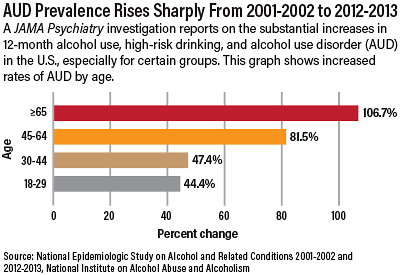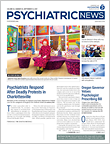In his more than four decades as a psychiatrist and alcohol and drug researcher, Marc A. Schuckit, M.D., said he has never seen such an alarming increase in heavy drinking among older people as he did coming from a major epidemiologic survey published in August in JAMA Psychiatry.
“What caught my eye and concerns me most are the increased rates of high-risk drinking among people 45 and older [81 percent], and the 106 percent increase in alcohol use disorder among people 65 and older,” Schuckit, distinguished professor of psychiatry at the University of California, San Diego, told Psychiatric News. “Drinking is especially dangerous for the elderly because they are more sensitive to sedating drug effects. They will have a higher blood alcohol level per drink and a greater reaction per drink,” he said.
He also expressed concerns about college-age women, who are catching up to men by drinking more. They are experiencing more blackouts (when blood alcohol level goes too high), which can increase their chances of becoming victims of sexual abuse, alcohol-related liver problems, and puts them at a higher risk for breast cancer. Schuckit noted the vulnerability to alcohol abuse of low-income and less educated people, who may have only limited mental health care available to them.
The study’s data came from two large cohorts collected about 10 years apart—43,093 participants in the 2001-2002 National Epidemiologic Study on Alcohol and Related Conditions (NESARC) and 36,309 participants from the 2012-2013 NESARC study. Survey participants were interviewed face to face about their 12-month alcohol consumption, including how often they engaged in high-risk drinking (four or more alcoholic drinks for women, five or more for men) per week.
Between 2001-2002 and 2012-2013, the following changes in alcohol use in the United States took place:
•
The prevalence of adults with alcohol use disorder (AUD) rose by 49.4 percent, from 8.5 percent to 12.7 percent of the population—representing approximately 17.6 million and 29.9 million Americans, respectively.
•
High-risk drinking increased almost 30 percent, from 9.7 percent to 12.6 percent—representing 20.2 million and 29.6 million Americans, respectively.
•
Alcohol use increased by 11.2 percent, from 65.4 percent in 2001-2002 to 72.7 percent in 2012-2013.
•
Rates of AUDs rose even higher in certain groups: women (83.7 percent increase) racial/ethnic minorities (51.9 percent for Hispanic and 92.8 percent for African Americans), those with only high school education (57.8 percent), and those earning incomes of less than $20,000 (65.9 percent).
Why Is Alcohol Abuse Increasing?
“Since our focus has been on the opioid epidemic, we obviously are not paying enough attention to a surging alcohol use epidemic that may also harm a lot of people,” said Andrew J. Saxon, M.D., a professor of psychiatry and behavioral sciences at the University of Washington and director of the Center of Excellence in Substance Abuse Treatment and Education at VA Puget Sound Health Care System in Seattle, Wash.
Saxon said he could only speculate on how these numbers skyrocketed. “I do wonder if it’s related to the events of the recession, which as we all know caused a lot of dislocation and hardship—events that often lead people to turn more to alcohol. I also think binge drinking is becoming more acceptable among younger people and in the baby boomer generation,” said Saxon.
“Drinking norms and values have become more permissive among women, along with increases in educational and occupational opportunities and rising numbers of women in the workforce, all of which may have contributed to increased high-risk drinking and AUD in women during the past decade, compounded by the stress of working and raising a family,” the authors wrote.
The impact of excessive alcohol use in this country is a public health crisis, according to the authors. From 2006 to 2010, there were 88,000 deaths annually related to alcohol, but treatment rates for AUD remain low—at less than 10 percent—despite the existence of evidence-based behavioral and pharmacological approaches.
“The findings highlight the urgency of educating the public, policymakers, and health care professionals about high-risk drinking and AUD, destigmatizing these conditions, and encouraging those who cannot reduce their alcohol consumption on their own, despite substantial harm to themselves and others, to seek treatment,” wrote the researchers.
Recommended Treatment for Alcohol Disorders
Clinicians should routinely screen for alcohol disorders using clinical interviews, questionnaires, and blood tests. Treatments for alcohol-related disorders include motivational interviewing to help people evaluate their situation, brief interventions to guide them toward more healthy behaviors, detox to address withdrawal symptoms, cognitive-behavioral therapy (CBT) to avoid relapses, and judicious use of drugs to diminish cravings and discourage relapse, according to Schuckit, who wrote the article’s accompanying editorial in JAMA Psychiatry.
The best intervention is a combination of medication and psychotherapy, said Saxon, adding there are at least three evidence-based therapies, including 12-step facilitation, CBT, and motivational enhancement. In addition, three FDA-approved medications are available: naltrexone, acamprosate, and disulfiram. “There is also very good evidence for topiramate, although it is not FDA approved. There is a long-acting injectable formulation of the naltrexone that I often recommend because it obviates most concerns about medication adherence and requires at least a monthly check-in with a treatment provider to get the injection. Providers and patients should select from these options through shared decision making,” Saxon said.
If Schuckit had his way and sufficient funding, he would consider the use of prevention programs to help people determine whether they have genetically influenced or other types of risk factors. Knowing their personal risks may influence their behavior and decrease the probability of becoming heavy drinkers or developing AUD. “The programs would be much more effective if individuals’ particular vulnerabilities were identified and their relevance discussed,” he said.
The study was funded by the National Institute on Alcohol Abuse and Alcoholism and the National Institute on Drug Abuse. ■
“Prevalence of 12-Month Alcohol Use, High-Risk Drinking, and
DSM-IV Alcohol Use Disorder in the United States, 2001-2002 to 2012-2013” can be accessed
here.


